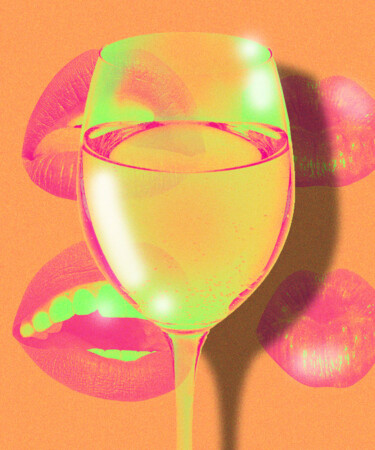Texture can be a perplexing term when it comes to wine. We can appreciate the difference between touching silk and Velcro, or between noshing on mashed potatoes and biting into an apple — but if wine is liquid, how can the term “texture” even apply?
Terms referring to texture are often used to describe the tannin structure in red wine. For example, the tannins in a Pinot Noir may be considered “silky,” while some Sangiovese wines could be coined as “grippy.” But when it comes to white wines, which generally lack tannins, texture takes on a whole new meaning: A white wine’s “texture” usually refers to the weight of the wine on your palate and its mouthfeel. Typically, the descriptors used to describe the way the wine feels when it rolls across your palate are similar to those used for food, like “creamy,” “oily,” or even “crunchy.”
To unpack the intricacies of texture in white wine, VinePair spoke with Dan Petroski, the founder and winemaker of Massican, the only winery in Napa Valley that exclusively makes white wines. Petroski crafts a line of both varietal wines and blends, which represent a range of textures that white wines can offer. He mentions that there are several factors that can contribute to a white wine’s texture that he considers throughout the winemaking process. Here are some elements that can transform white wine into a textural journey, from innate characteristics to stylistic decisions.
Grapes and Blending
The grape variety itself, as well as where it is grown, can determine the acidity and alcohol level of the wine. These characteristics contribute to the weight of the wine and how it feels on your palate. Petroski notes that the textural differences between grapes is apparent in his varietal wines, Massican Sauvignon Blanc and Chardonnay. The Sauvignon Blanc has a lower pH, and the acid lifts the entire feel of the wine, so it feels more zesty and punchy on the palate, whereas the Chardonnay has a slightly higher pH, giving it a more subtle, rounded character. Wines with a higher alcohol percentage can also have a heavier, more viscous feeling on the palate.
Petroski also considers the texture of the final wine in constructing the compositions for his unique and wildly popular blends, Annia and Gemina. In the example of the Annia, which is a blend of grapes common in northeast Italy’s Friuli region, Ribolla Gialla, Tocai Friulano, and Chardonnay, Petroski thinks of the blend as building a house on the palate. The Ribolla Gialla is the floor or the base, providing an earthy, savory texture. The Tocai Friulano is the ceiling; it lacks texture but provides the aromatics. And the Chardonnay is like the walls that keep it all together with its acidity as well as its oily, creamy texture. The Tocai Friulano alone would only provide one note, but blends like this can ensure the wine has a cohesive and enticing feeling across the palate.
Winemaking
Aging a wine on its “lees” — the dead yeast cells that result from the fermentation process — is another way to impart texture in white wine. Additionally, if the winemaker chooses to implement “battonage,” which is a technique that involves softly stirring the wine to distribute the lees and give them greater contact with the wine, the wine itself can take on an even richer texture. As white wine drinkers are starting to look for more complexity of texture, many winemakers are using this method to give white wines richness and delightful, creamy mouthfeel without the overbearing oak character that many shy away from. This technique is especially popular in the wines of Muscadet Sèvre et Maine, an appellation in the Loire Valley where the wines are made from the acidic and light Melon de Bourgogne grape.
Another technique that can introduce more weighty creaminess is malolactic fermentation. Also referred to as secondary fermentation, the process uses certain bacteria to convert malic acid — which can taste like green apples — into lactic acid, which has more of a buttery flavor. While red wines usually undergo malolactic fermentation, only some producers choose to allow this in their white wines. This results in a rich texture, common in many California Chardonnays.
Barrel Choice
Further, the type of vessel the wine is fermented or aged in can add a richer texture to a white wine as well. One of those vessels, which can be quite divisive, is oak barrels. The type and age of the oak barrels can make a difference as well, with old oak introducing oxygen to the wine without imparting strong oak flavors, and new oak barrels adding the extra element of oak-derived characteristics. For the Massican Chardonnay, Petroski ferments and ages the wine in French oak barrels.
“The oak influence on the Chardonnay takes the texture profile from lemon zest to lemon oil,” states Petroski. “Oak gives the wine an oily texture that lends it the ability to glide onto the palate, then the acid finally catches up and cleans off the palate, making you want a second sip.”
